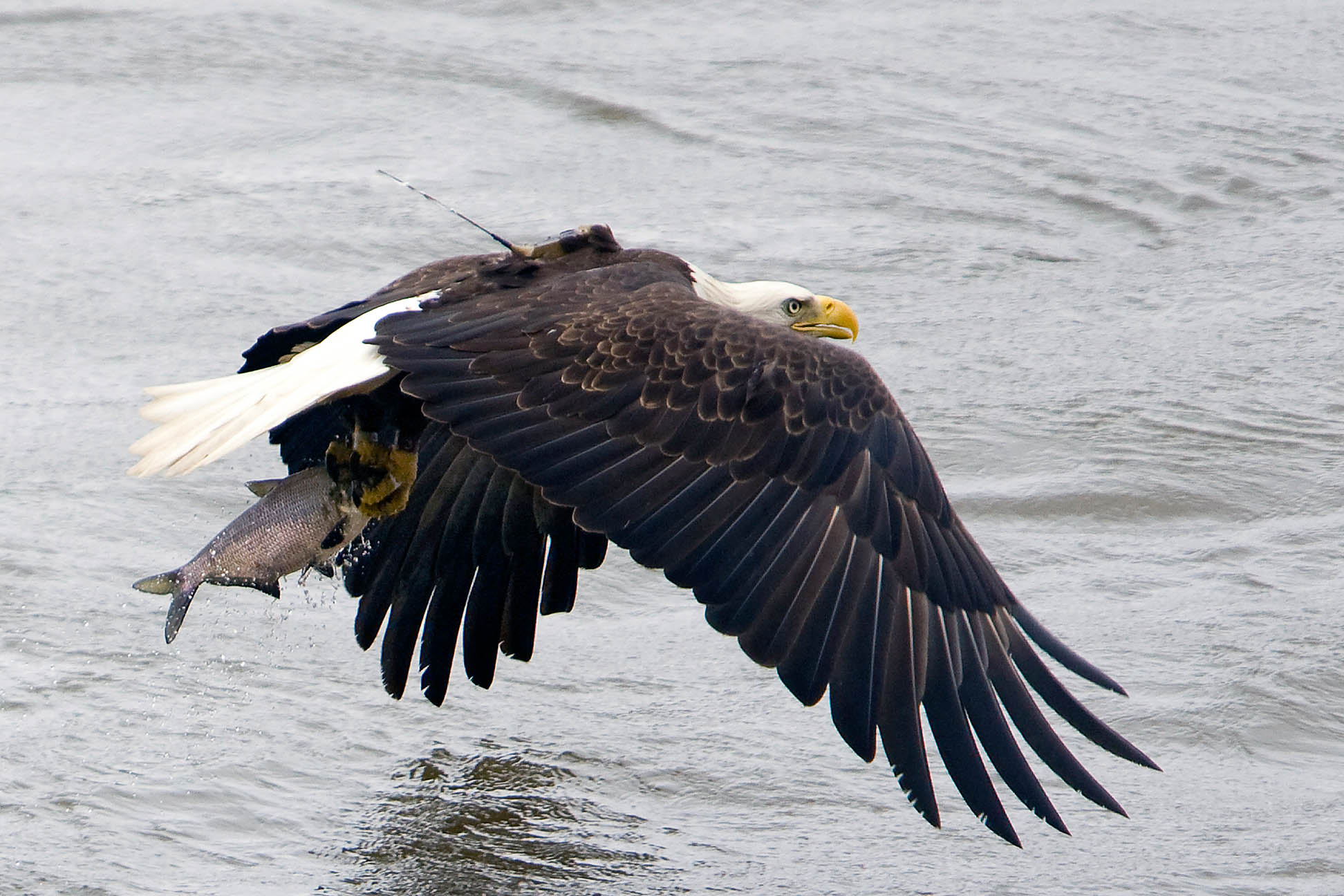Conowingo Dam: a great place to view eagles and to resight eagle bands
Azalea Continues Her Wanderings
September 6, 2009Tracking whimbrels to tropical wintering grounds
September 7, 2009
Written by Bryan Watts & Elizabeth Mojica
September 6, 2009
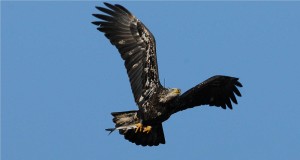
Charles Lentz photographed satellite transmitter-wearing immature male bald eagle, Hudson (banded blue S/47 as a nestling, by NYDEC), with a fish in its talons at Conowingo Dam. Photo by Charles Lentz.
The spillway below the Conowingo dam near the mouth of the Susquehanna River is likely the best eagle viewing location in Eastern North America. The site attracts non-breeding eagles from populations along the entire Atlantic Coast. Though numbers peak around 300 in the late fall and winter periods, there are thousands of individuals that come and go through this site over the course of a year. The site is strategically positioned within the upper Chesapeake Bay Bald Eagle Concentration Area, a region that draws migrant eagles from as far north as the maritime provinces of Canada down to Florida. Eagles are attracted to the site by the high availability of accessible fish around the outflow of the dam and the abundant waterfowl.
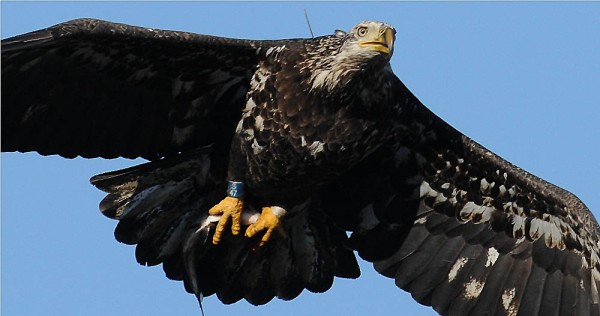
Charles Lentz photographed satellite transmitter-wearing immature male bald eagle, Hudson (banded blue S/47 as a nestling, by NYDEC), with a fish in its talons at Conowingo Dam. Photo by Charles Lentz.
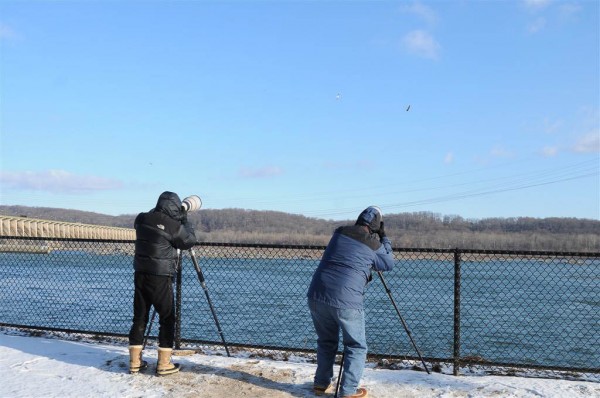
Craig Koppie captured photos of an eagle chase, plus a peek at wildlife photographers awaiting the perfect shot below Conowingo Dam. Photo by Craig Koppie.
Conowingo has had a long history of great eagle watching, in part because the visitor center at the base of the dam and a new pier that allows viewers and photographers to stand at water level and watch foraging eagles at close range. Eagles perch in the trees along the river, fighting over fish and flying low over visitor’s heads. For those interested in high wildlife drama, It is a spectacle not to be missed. Beyond the drama, the site is an important data collection site for eagle researchers. Generations of eagle biologists have banded eagles for years along the eastern seaboard. Eagles are fitted with two metal leg bands to assist researchers with identifying birds in the future. Each state bands eagles with a silver federal band on one leg and a uniquely-colored band coded with easy-to-resight, alpha-numeric characters on the other leg. Hundreds of birds have been banded in this way and each may be identified by reading the band code. Because Conowingo concentrates birds from several populations, it provides a great opportunity to identify good numbers of marked birds.
Resighting of banded birds has contributed a great deal to what we know about species’ dispersal/movement patterns and survivorship. Conowingo provides an opportunity to simultaneously watch eagles and contribute to ongoing research by reading and reporting band combinations.
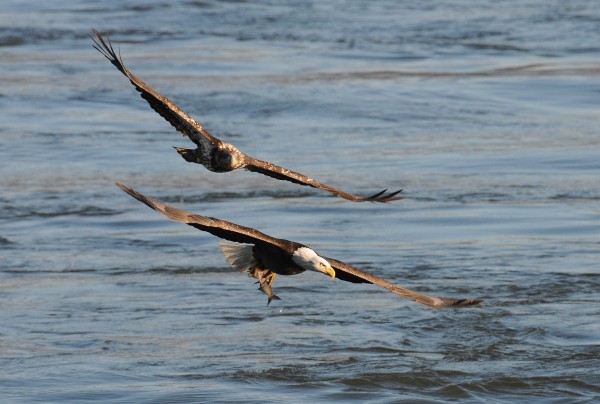
Craig Koppie captured photos of an eagle chase, plus a peek at wildlife photographers awaiting the perfect shot below Conowingo Dam. Photo by Craig Koppie.
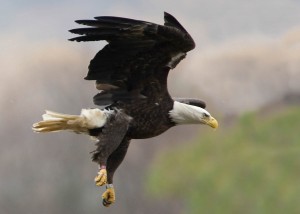
An adult male bald eagle named Nanjemoy, a local bird named for Maryland’s Nanjemoy Natural Resource Managment Area, flying above the reservoir and then catching a fish at Conowingo Dam. Photo by Ted Ellis.
Eagle watchers who observe banded eagles are encouraged to contact the appropriate state band contact by following the directions on this site: www.ccb-wm.org/bands/baldeagle.html. In Maryland and Virginia, eagles are banded with purple leg bands. To report seeing a purple band, contact CCB at 757-221-1645. In addition, photographs of banded eagles are indispensible for reading the alphanumeric codes on the bands and confirming the identity of an individual bird.
The Conowingo Dam is located on the lower Susquehanna River, forming the Susquehanna River Reservoir 10 miles upstream from where the river meets the bay. This area of the Chesapeake Bay is rich in fish and waterfowl prey which attract thousands of foraging eagles in both winter and summer months.
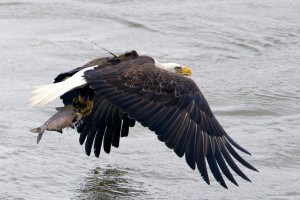
An adult male bald eagle named Nanjemoy, a local bird named for Maryland’s Nanjemoy Natural Resource Managment Area, flying above the reservoir and then catching a fish at Conowingo Dam. Photo by Ted Ellis.
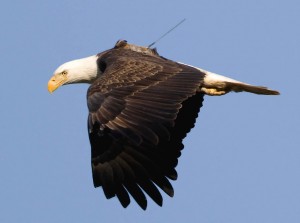
An adult female bald eagle, Champlain (banded purple M/2 by the Center for Conservation Biology), at Conowingo Dam. Champlain was named for her summering location of Lake Champlain, on the border of New York and Vermont. Photo by Robert Lin.
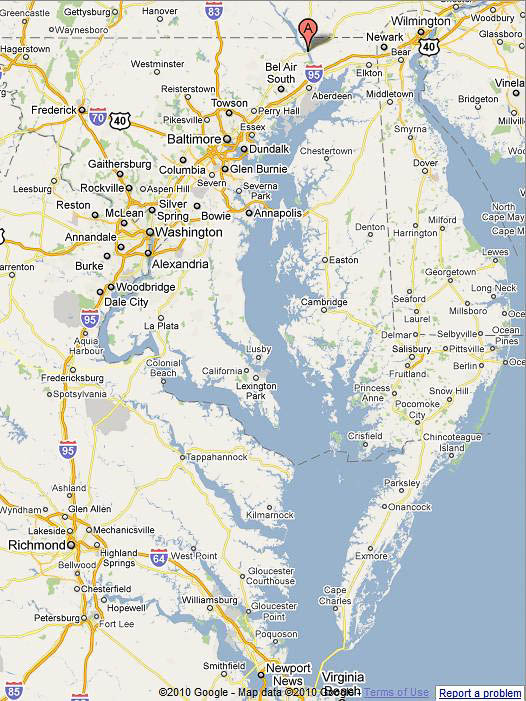
Conowingo Dam is at the north end of the Chesapeake Bay, near the mouth of the Susquehanna River. Map by Google Maps.

